Day 1 :
Keynote Forum
Yuichi Setsuhara
Osaka University, Japan
Keynote: Reactive plasma processes for formation of high-mobility IGZO thin-film transistors
Time : 09:00-09:40

Biography:
Yuichi Setsuhara received his Dr. Eng. in Electrical Engineering from Osaka University in 1991. He joined Welding Research Institute, Osaka University as Research Associate in 1991, Department of Aeronautics and Astronautics, Graduate School of Engineering, Kyoto University as Associate Professor in 2001, and has been a Professor in Joining and Welding Research Institute, Osaka University since 2004. He is currently a Vice Director of Joining and Welding Research Institute (JWRI), Osaka University since 2014. He has published more than 150 papers in SCI journals and has been serving as Board Members of several committees such as International Scientific Committee for International Conference on Plasma Surface Engineering and International Advisory Board for the journal “Plasma Processes and Polymers”.
Abstract:
Reactive plasma process systems have been developed via installation of inductively-coupled plasmas (ICP) sustained with low-inductance antenna (LIA) for low-temperature fabrication of flexible electronics, which require large area and low damage processes with reactivity control capabilities at low substrate temperature. Major advantage of the reactive processing system is that the reactivity during film-deposition processes can be enhanced and controlled via low-damage and high-density plasma production for low-temperature processing of devices. The reactive plasma processes have been applied to sputtering deposition of transparent amorphous oxide semiconductor a-InGaZnOx (a-IGZO), which has attracted great attentions as key material for next-generation flexible electronics. So far post annealing at elevated temperature (as high as 400ºC) was required. Thus the conventional process for fabrication of the IGZO TFTs has been carried out on glass substrates. With the advanced reactivity controlled plasma processes in this study, a-IGZO thin-film transistors (TFTs) with mobility as high as or higher than 40 cm2/Vs was successfully formed at substrate temperature less than 200ºC. In this presentation, the reactive plasma processes are presented for low-temperature formation of IGZO TFTs.

Keynote Forum
Jikui Luo
University of Bolton, UK
Keynote: Material synthesis and optimization for high performance triboelectric
Time : 09:40-10:20

Biography:
Jikui Luo received his PhD Degree from the University of Hokkaido, Japan in 1989. He worked in Cardiff University as a Research Fellow, in Newport Wafer Fab., Philips Semiconductor Co. and Cavendish Kinetics Ltd as an Engineer, Senior Engineer and Manager and then in Cambridge University as a Senior Researcher from 2000. From January 2007, he became a Professor in MEMS at the Centre for Material Research and Innovation (CMRI), University of Bolton. His current research interests focus on sensors, actuators, flexible/wearable electronics and lab-on-chips for biotechnology and healthcare applications, and nanomaterials, nanodevices, energy harvesting technology, wireless sensors, etc. He has over 230 publications in peer review international journals, and about 190 talks and presentations at international conferences, among them about 40 are invited talks or plenary/keynote speaks.
Abstract:
Energy harvesting technology is an emerging technology, particularly important for the wireless sensor networks as it is the core technology for internet of things (IoT), smart manufacturing and smart cities, etc. Since, wireless sensors are typically installed on mobile objects, in remote areas or harsh environments, it is extremely challenging to maintain their long-term sensing/monitoring function due to the requests for constant electrical power or periodical replacement of batteries. Energy harvesting technologies have been explored to power wireless sensors by utilizing piezoelectric, pyroelectric, electromagnetic and triboelectric effects. Triboelectric nanogenerator (TENG) is regarded as the most suitable one owing to its very high power outputs and conversion efficiency. Great efforts focus on the performance enhancement through the innovations to increase surface charge density. Searching for better materials and optimal combinationand modifying materials properties are the two common methods for obtaining triboelectric materials with high surface charge densities. We have been working on these for a while and achieved composite materials with excellent triboelectric properties and various optimal material combinations for TENGs. The talk will highlight our work on the best tribo-positive materials, synthesis of tribo-negative composites using polyvinylidene difluoride (PVDF) or polytetrafluoroethylene (PTFE) incorporated with piezo/ferroelectric nanomaterials such as ZnO and Barium titanate (BTO) etc, and specific design for the electrode and tribomaterial interfaces. Using the best material combination and optimized device structures, we have fabricated flat-surface TENGs with peak voltage output over 1200 V and instantaneous power density in the range of 40-120 W/m2 with excellent stable function. Author will also present our latest unique technologies of the TENG-based chipless wireless sensors with self-identification capability and TENG as a wireless power source.
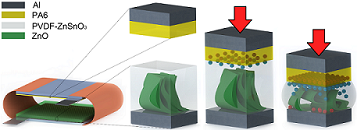
Figure 1: Schematic and working mechanism of the TENG with an incorporated interfacial ZnO nanosheets piezoelectric layer.

Figure 2: Schematic drawing of the instantaneously self-powered chipless wireless sensors with self-identification capability.
Keynote Forum
Pascal Boulet
Aix-Marseille University, France
Keynote: Charge density distribution as a tool for understanding relationships between structure and properties of thermoelectrics
Time : 10:20-11:00

Biography:
Pascal Boulet has earned his PhD thesis Diploma from both the University of Lyon, France and the University of Geneva, Switzerland in 2001 under the supervision of Prof. H. Chermette and Prof. J Weber. His PhD thesis was related to the density-functional theory calculations on heterogeneous catalytic processes, photochemical processes in organic and organometallic species using time-dependent DFT and electron density based chemical reactivity indexes. He then moved to University College London, UK in Prof. P. V. Coveney's group where he worked as a Postdoctoral Research Fellow on clay polymers nanocomposite materials using monte carlo and molecular dynamics simulations. From 2004 to 2017, he was Associate Professor at the University of Aix-Marseille, France where he got a full professorship position in 2017. His field of interest mainly deals with transport properties in bulk and low-dimensional materials for energy applications (thermoelectricity and photovoltaics). He has published over 60 papers in renowned journals.
Abstract:
For three decades density-functional theory (DFT) has imposed itself as an accurate quantum method to investigate materials properties from the perspective of the charge density, which is readily accessible from fast calculations. In parallel, developments of density-based descriptors such as Bader’s quantum theory of atoms in molecules (QTAIM) brought new insights into materials properties. The thermoelectric properties (TE) can be evaluated from combined DFT electronic band structures calculations and Boltzmann’s semi-classical formalism. It is well known that TE properties may be significantly affected by structure modifications such as doping, nano-structuring or strains application. In this lecture author will present results of TE properties calculations performed on modified materials and their relationships with the perturbations induced by these modifications on the electronic band structure and on the crystal atomic structure and bonding network investigated using Bader’s theory of atoms in molecules.
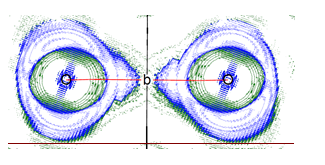
Figure: Electron density laplacian between two atoms in resonant interaction
- Advanced Energy Materials | Solar Energy Materials | Advanced Graphene & 2D Materials | Advanced Nanomaterials | Hydrogen Energy and Fuel Cell Technology | Energy Harvesting Materials
Location: London I

Chair
Marie-Christine Record
Aix-Marseille University, France

Co-Chair
Mineo Hiramatsu
Meijo University, Japan
Session Introduction
Marie-Christine Record
Aix-Marseille University, France
Title: Investigation of the CuIn1-xAlxSe2 structure-properties relationships by coupling density functional and Bader’s theories
Time : 11:15-11:45

Biography:
Marie-Christine Record is Full Professor of Materials Chemistry at the University of Aix-Marseille, France since 2004. Her field of interest is solid state chemistry both from the experimental and computational stand points. Her experimental skills spread from the determination of phase diagrams and the synthesis of materials, by using methods as varied as mechanical alloying, self-propagating high temperature synthesis (SHS), reactive diffusion in thin films and electro chemical atomic layer epitaxy (EC-ALD), to materials structures (X-ray diffraction) and properties (electronic) characterization. For the purpose of better understanding the materials structure-properties relationships, she has developed for more than a decade computational strategies based on ab initio methods. She has been working on different kinds of materials such as intermetallics, chalcogenides for application purposes, especially for thermoelectric ones. She is author and co-author of more than 90 papers published in international scientific journals.
Abstract:
For three decades density functional theory (DFT) has imposed itself as an accurate quantum method to investigate materials properties. In parallel, developments of density based descriptors such as Bader’s quantum theory of atoms in molecules (QTAIM) brought new insights into the chemical bonding of materials. The ternary Cu-based chalcopyrite compound, CuInSe2 (CIS), is an interesting material as solar cell absorber layer due to its low cost, high absorption coefficient, excellent optical and electrical properties. Many approaches have been adopted to improve its energy conversion efficiency. However, its narrow band gap and the scarcity and expensiveness of indium constrain its large-scale development. Replacing indium by the abundant and inexpensive aluminum to form the quaternary CuIn1-xAlxSe2 (CIAS), has been considered as a promising alternative with few changes in physical and chemical properties. In this work, we investigated by DFT calculations the structural, electronic and optical properties of CuIn1-xAlxSe2, for various “x” from 0 to 1, and determined the optimal substituting percentage. Moreover, in current PV cells, strains originating from the lattice mismatch between the PV materials and the substrates inevitably influence the optical performances, we calculated the band gap and optical properties for the optimal alloy subjected to biaxial strains. In the aim to unravel the deep relationship between bond interactions and optical properties, a detailed investigation of topological properties based on the electron density has been conducted as strain is applied.
Shahed U M Khan
Duquesne University, USA
Title: Electrochemically fabricated substrate dependent smart electrocatalysts Ni-Fe double and Ni-Co-Fe triple hydroxides for efficient water splitting to oxygen and hydrogen
Time : 11:45-12:15
Biography:
Shahed U M Khan has his expertise in the synthesis of materials for the electrochemical and photoelectrochemical splitting of water. He published more than 140 papers in various journals including some top ones such “Journal of Physical Chemistry”, “Journal of American Chemical Society”, “Journal of Electrochemical Society”, “Chemical Physics, Applied Physics and Science”. He co-authored books entitled “Quantum Electrochemistry”, “Surface Electrochemistry” and co-edited volume 7 of “Comprehensive Treatise of Electrochemistry.” The focus of his research is to synthesize highly stable energy materials based on naturally abundant sources for efficient splitting of water to oxygen and hydrogen, a clean fuel to have carbon footprint free society in the planet Earth.
Abstract:
Water electrolysis is a significant method that can utilize renewable energy to produce hydrogen; a fuel that can transform earth towards a clean energy future. Activity of electrocatalysts for water oxidation is fundamental for energy conversion technologies including integrated solar power generating devices and water electrolyzers. In this study we have electrochemically fabricated the naturally abundant and stable electrocatalysts Ni-Fe-double hydroxides, Ni-Fe-Co-triple hydroxides, for efficient splitting of water to oxygen and clean fuel hydrogen. Oxygen-evolution activities of these electrocatalysts were examined in an alkaline solution of KOH. We focused in determining electro-catalytic activity of these double and triple hydroxides electrodeposited on different substrates such as Ni-foam, electrodeposited Ni-Co-oxide on Ni-foam and pressed porous Ni-Co oxide under varying electrodeposition bath composition, electrodeposition time and electrodeposition current and potentials. We found that Ni-Fe-Co triple hydroxide electrodeposited for total of 10 min on pressed porous Ni-Co-oxide sheet acted as a superior electrocatalyst for oxygen evolution reaction during water splitting reaction. This electrocatalyst generated a current density of ~ 100.0 mA cm-2 at an oxygen overpotential of 0.270 volt (= 1.5-volt vs RHE) in 1.0 M KOH at electrolyte temperature of 25oC. However, this triple hydroxide deposited for 7 min generated 81.0 mA cm-2 at the same overpotential, electrolyte concentration and temperature. The synergetic effect of multiple hydroxides and the substrates was mostly responsible for such enhanced electro-catalytic activity. The effect of higher electrolyte temperature was also found to have important role in enhancing the current density because of exponential dependence of reaction rate on temperature. The surface morphology and the composition of these electrocatalysts were determined using the scanning electron microscope (SEM) and energy dispersive spectroscopic (EDS) data.
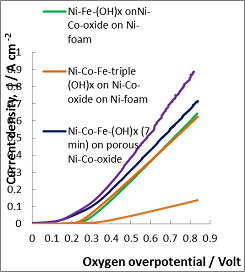
Figure 1: The oxygen evolution current density versus oxygen overpotential on Ni-Fe-double hydroxides and Ni-Co-Fe-triple hydroxides electrodeposited on various substrates such as Ni-foam, Ni-Co-oxide on Ni-foam and on pressed porous Ni-Co-oxide in 1 M KOH at electrolyte temperature of 25oC measured using the scan rates of 5 mV/sec.
Mineo Hiramatsu
Meijo University, Japan
Title: Synthesis of vertical graphene network as platform for electrochemical applications
Time : 12:15-12:45

Biography:
Mineo Hiramatsu is a Full Professor of Department of Electrical and Electronic Engineering and the Director of Research Institute, Meijo University, Japan. He served as the Director of The Japan Society of Applied Physics. His main fields of research are plasma diagnostics and plasma processing for the synthesis of thin films and nanostructured materials. He served as Chairman and Member of organizing and scientific committees of international conferences on plasma chemistry and plasma processing. He was awarded the Japan Society of Applied Physics Fellow in 2017.
Abstract:
Graphene based materials such as carbon nanotube and graphene sheet itself have a wide range of possible applications. Among these grapheme based materials, carbon nanowalls (CNWs) are self- supported network of few-layer graphenes standing almost vertically on the substrate to form 3-dimensional structure. The maze-like architecture of CNWs with large-surface area graphene planes would be useful as electrodes for energy storage devices, electrochemical and biosensors and scaffold for cell culturing. CNWs and related materials can be synthesized by several plasma enhanced chemical vapor deposition (PECVD) techniques on heated substrates employing CH4 and H2 mixtures. Control of CNW structures including spacing between adjacent nanowalls and crystallinity is significant for the practical applications. Moreover, surface functionalization including surface termination and decoration with catalytic metal nanoparticles should be established. We report the current status of fabrication and structure control of CNWs using several PECVD techniques. Moreover, CNW surface was decorated with Pt nanoparticles by the reduction of chloroplatinic acid or by the metal-organic chemical deposition employing supercritical fluid. We also report the performances of hydrogen peroxide (H2O2) sensor and fuel cell, where CNW electrode was used. For the H2O2 sensing application, CNWs were grown on carbon fiber paper (CFP) using PECVD with CH4/Ar mixture to increase the surface area. Then, CNW surface was decorated with Pt nanoparticles by the reduction of H2PtCl6 in solution. Cyclic voltammetry results showed that the Pt-decorated CNWs/CFP electrode exhibited excellent electrocatalytic activity to the reduction of H2O2. Similar structure was also used as a catalytic layer of the polymer electrolyte fuel cell. From the electrochemical investigation, Pt-decorated CNWs showed excellent electrochemical durability compared with the carbon black. Electrochemical experiments demonstrate that platform based on vertical nanographene offers great promise for providing a new class of nanostructured electrodes for electrochemical sensing and energy conversion applications.
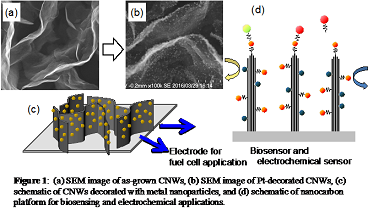
Fabio Ricci
University of Liège, Belgium
Title: Magnetic instability in heavily n-doped Fe-based full Heusler compounds: Origin and impact on thermoelectric properties
Time : 12:45-13:15

Biography:
Fabio Ricci did his PhD on both simulations and experimental measurements on magnetic properties of materials (diluted magnetic semiconductors and soft magnetic materials) by means of the magneto-optical Kerr effect. Subsequently, he worked on theoretical simulations on Fe-based superconductors, principally iron-chalcogenides. He developed and implemented in the ABINIT code the formalism for the non-collinear magnetism in the density functional perturbation theory and, at the same time, started to work on the theoretical engineering of thermoelectric properties of the Fe-based full-Heusler compounds.
Abstract:
Fe2YZ full Heusler compounds, on which first principles on density functional theory (DFT) simulations predict very large thermoelectric power factor (PF), are promising candidates for thermoelectric applications. The building blocks of their interesting thermoelectric properties are the carriers belonging to the Fe-eg orbitals that can be opportunely engineered to maximize PF [2]. These anti-bonding states are represented by a flat band (mainly composed of Fe dx2-y2 character) along the ΓX direction of the Brillouin Zone, related to the highly directional Fe-Fe bond, becoming dispersive along the other directions. This band satisfies the “flat-and-dispersive” requirements proposed by Mahan and Sofo [3] and leads to one-dimensional transport strongly enhancing the PF. However, due to its strongly localized nature, explicit n-doping may induce a Stoner instability driving the system to a half-metallic phase. The present study [4], performed through DFT using both hybrid functional and GGA+U methods on Fe2YZ1-xAx (Y = Ti, V, Nb, Ta, Z=Al, Si, Sn, Ga and A=Si, P, Sb, Ge) n-doped systems, shows that the appearance of such a magnetic phase is strictly linked to the Fe-eg and Y-site eg orbital hybridization and that it possesses a pure electronic origin, independent on the dopant species. Although the Stoner instability can provide half-metallicity with coupled thermomagnetic responses, the PF is typically reduced in the half-metallic phase due to a reduction of the number of carriers available at the Fermi level. In certain cases, however, the values of the PF are still large (for Fe2TaGa1-xGex or Fe2TiSi1-xPx PF is between 9 and 15 10-3 W K-2 m-1 at 600 K, for example) which stays promising for thermoelectric applications. Going further, we elucidate the possibility to exploit the broader nature of 4d and 5d orbitals at the bottom of the conduction band to overcome the magnetic phase appearance in the doping range of interest.
N M Ferreira
Universidade de Aveiro, Portugal
Title: Ceramic based thermoelectric materials processed by laser
Time : 14:00-14:30

Biography:
N M Ferreira is a PhD in Physics Engineering; currently is a Researcher at i3N, Physics Department at University of Aveiro, Portugal. He had participated in several R&D projects on Material Science. He have experience as researcher in study and development of ceramics-based materials, prepared through conventional methods by melting, solid stated, with particular focus on laser processing (crystal growth – LFZ and surface sintering/modification). Present sample characterization skills include various techniques such as, electrical conductivity and magnetic properties of various oxide materials. Current focus materials are thermoelectrics, ferroelectrics and glass matrices doped with transition metals and rare earth for energy storage and conversion applications. Main expertise is related to structural, magnetic and electrical properties of materials prepared by laser processing.
Abstract:
Today a particular interest is given to the oxide-based thermoelectric materials, due to enhanced thermal and redox stability, attractive properties at high temperature, together with the absence of toxicity, and natural abundance of the constituent compounds. The objective of this work is to assess the possibilities for processing oxide thermoelectrics through laser floating zone (LFZ) method, including identification of the appropriate treatment conditions and main structural and microstructural factors affecting the thermoelectric performance. Known that Nb and La substituted calcium manganite-based materials possesses promising thermoelectric properties, they were selected as a model system. Detailed structural (XRD) and microstructural (SEM/EDS) studies were performed for the samples grown at various pulling rates. The results on electrical conductivity, Seebeck coefficient and thermal conductivity indicate that high thermoelectric performance can be triggered by laser processing. Effects of pulling rate, dopants nature and thermal treatment to the fibres on that properties are discussed, suggesting that careful optimization of the laser treatment conditions is necessary, when seeking high thermoelectric performance in oxides by LFZ processing.
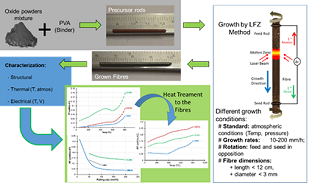
Gabriel J Man
Uppsala University, Sweden
Title: A framework for critically assessing the ideality of carrier-selective contacts for solar cells
Time : 14:30-15:00
Biography:
Gabriel Man has worked as a Postdoctoral researcher in the Division of Molecular and Condensed Matter Physics at Uppsala University since April 2018. In his current work, he applies and develops X-ray spectroscopic techniques to gain fundamental understanding of the relationships between the crystal and electronic structures of advanced energy materials. His work spans both fundamental and applied science, and is guided by his background in engineering and technology entrepreneurship. Prior to his postdoctoral appointment, Gabriel spent nearly a year working in industry as a device engineer/physicist at a thin film solar cell startup company. Gabriel received his PhD in 2017 in Electrical Engineering and Materials Science from Princeton University (New Jersey, USA) under the supervision of Prof. Antoine Kahn. His PhD research was partially supported by a prestigious PhD fellowship from the Natural Sciences and Engineering Research Council of Canada (NSERC), and by a fellowship from Princeton University.
Abstract:
The simplest solar cell consists of a light absorber, sandwiched between two metals with dissimilar work functions. Carrier-selective contacts (CSC’s), which are ubiquitous in modern solar cells, are added to improve the electrical performance. The proper design and implementation of a CSC is crucial, as the performance, lifetime, and/or cost reduction of a solar cell can be hampered by a single interface or layer. A framework, consisting of eight core requirements, was developed from first-principles to evaluate the effectiveness of a given CSC. The framework includes some requirements which are well-recognized, such as the need for appropriate band offsets, and some requirements which are not well-recognized at the moment, such as the need for effective valence/conduction band density of states matching between the absorber and CSC. The application of the framework to multiple silicon-based CSC’s revealed the difficulties of effectively designing and implementing a CSC. Three metal oxide/silicon heterojunctions - titanium dioxide/silicon (TiO2/Si), zinc oxide/silicon (ZnO/Si), and tin dioxide/silicon (SnO2/Si) - initially expected to yield similar electron-selective contacts (ESC’s) were instead discovered to be widely different in terms of their suitability as an ESC.
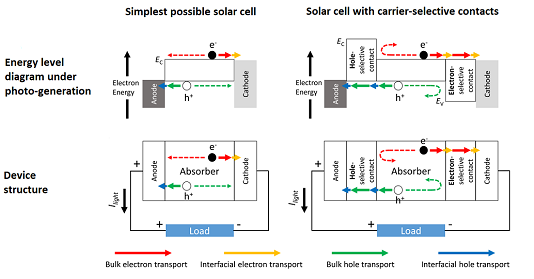
S Ghosh
Indian Institute of Engineering Science and Technology, India
Title: Solar PV/T integrated reversible solid oxide fuel cell system for power generation and storage
Time : 16:15-16:45

Biography:
S Ghosh is an Associate Professor in the Department of Mechanical Engineering, Indian Institute of Engineering Science and Technology, Shibpur. He received his Bachelor of Engineering (Mechanical) from University of North Bengal, India, in 1991, Master of Engineering (Heat Power) from Calcutta University, in 1993 and PhD from Jadavpur University in 2005. Besides having a two-decade long teaching and research experience, his career includes industrial work experience at ABB ABL, Durgapur, India (later taken over by Alstom Power). His areas of research include Clean Coal Technology, Renewable Energy Technologies like Fuel Cells, Biomass Gasification and Greenhouse Technology. He is closely associated with a few renewable energy research groups in Europe, USA and Canada and he has served as Guest Scientist at Paul Scherrer Institute (PSI), Switzerland (during 2006 and 2007), where his focus of work was development and technology demonstration of biomass gasification integrated fuel cell (SOFC) system.
Abstract:
In this paper, a novel power generation cum storage system employing reversible solid oxide fuel cell (RSOFC) has been proposed. The RSOFC is integrated with solar PV/T system that also includes parabolic trough solar collectors (PTSC). The RSOFC unit operates in steam electrolyser mode (during day time) and in fuel cell mode (during night time). The electrochemical model is developed for a proton conducting reversible solid oxide fuel cell (RSOFC-H) and its performance analysis is done both in fuel cell mode and electrolysis mode of operation. A comparative performance analysis has also been done between conventional oxide ion conducting reversible SOFC (RSOFC-O) and proton conducting RSOFC-H for suitably chosen range of current density to cover both the cells' common operating range (500 A/m2 to 5000A/m2). Computational simulation model for the integrated plant has been developed and the simulated performance analyzed both using energy and exergy approaches. The results suggest that the solar-integrated system can yield an overall solar-to-gas conversion efficiency of about 18% in electrolysis mode while in fuel cell mode the conversion efficiency (gas-to-power) would be about 40%.
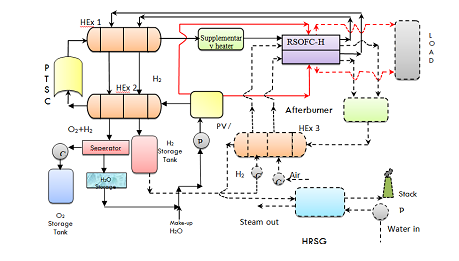
Figure: Solar integrated RSOFC power generation cum storage system
Sabiha Akter Monny
The University of Queensland, Australia
Title: Semiconductor nanostructure engineering for solar hydrogen production
Time : 16:45-17:15

Biography:
Sabiha Akter Monny is a PhD student at the University of Queensland. She specialises in renewable energy, energy conversion, and nanomaterials. Her research focuses on developing photocatalysts using semiconductor nanomaterials for photoelectrochemical energy conversion.
Abstract:
Photoelecctrochemcial water splitting provides an attractive method to convert the abundant solar energy into sustainable and clean hydrogen energy. The greatest challenge is how to develop efficient and stable photoelectrodes, including photoanodes and photocathodes. Comparing to the widely studied photoanodes, the photocathodes have been paid less attention due to the scarcity of suitable semiconductor candidates. Some available photocathodes derived from p-type semiconductors such as single crystal Si, chalcogenide (e.g., CuInGaSe) are either not stable or too expensive to realize large scale application. Herein, a promising p-type semiconductor, CuBi2O4, has been used to fabricate efficient photocathode. Moreover, combining the CuBi2O4 photocathode with well-developed BiVO4 photoanode, it is able to demonstrate unbiased sunlight-driven solar water splitting. CuBi2O4 electrodes were prepared with electrodeposited BiOI and copper acetylacetonate as precusor after heating in air at 450oC for 4 hours. The CuBi2O4 photocathode possesses a porous nano branch strucutre and showed a photocurrent of -0.95 mA/cm2 at 0.21 VRHE along with an onset potential at 1.1 VRHE in Sodium Phosphate (~pH 7) electrolyte. With the presence of electron scavengers, the photocurrent was further enhanced to -2.4 mA/cm2 at 0.48 VRHE. The incident photon-to-current efficiency showed a threshold at ca. 620 nm, suggesting a broad light harvesting range of the CuBi2O4 photocathode. Furthermore, the large onset potential of CuBi2O4 photocathode makes it feasible to realize unbiased photoelectrode water splitting when combined with suitable photoanode, such as BiVO4.
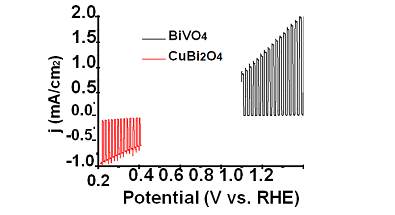
Figure: The photoresponse of CuBi2O4 and BiVO4 under chopped light. In conclusion, we have developed a new method for fabricating the state-of-the-art CuBi2O4 photocathode. Further combining with BiVO4 photoanode, it can achieve efficient unbiased water splitting.
